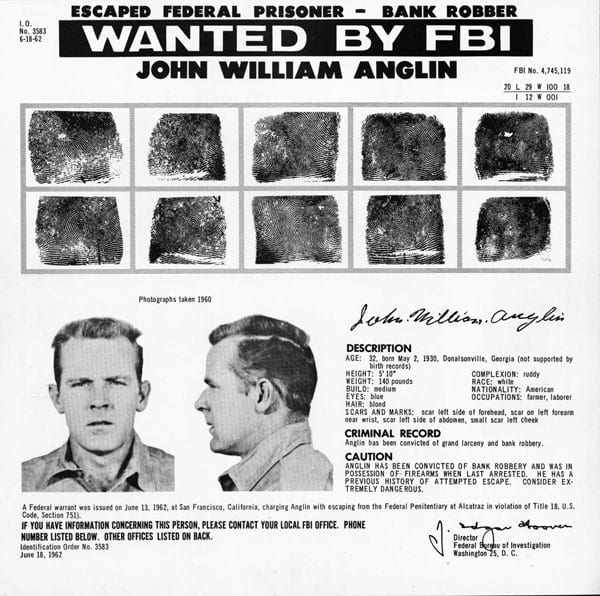Most people know about the notorious 1962 Alcatraz prison break from the 1979 Clint Eastwood film Escape From Alcatraz.
The film thrust the true story of inmates Frank Morris, Clarence Anglin, and his brother John Anglin into the public consciousness and was regarded as one of the best movies of 1979. While the film version of the daring escape has remained popular throughout the years, the true story has continued to fascinate the public as well.

Photo Credit: Paramount Pictures
Alcatraz, located in the middle of San Francisco Bay, was thought to be escape-proof. Notorious inmates such as Al Capone, “Machine Gun” Kelly, and James “Whitey” Bulger did hard time on “The Rock” during its days as a federal prison from 1934 until 1963. Tourists visit the island prison these days to learn about its history, but one mystery about Alcatraz has still never been solved. Did the three men who attempted to escape on June 11, 1962 make it all the way to freedom?

Photo Credit: Wikipedia
Throughout the 29 years that Alcatraz functioned as a prison, 41 inmates attempted to escape. Of those, 26 were captured, 7 were shot dead by guards, 3 drowned, and 5 disappeared forever. Frank Morris and Clarence and John Anglin were among those who were never found.
All three men were serving lengthy sentences for bank robbery. Frank Morris, a career criminal who had previously done time in Florida, Georgia, and Louisiana, was sent to The Rock in 1960 for a 14-year term. The Anglin brothers had attempted earlier escapes from other prisons, and were sent to Alcatraz for robbing a bank in Alabama. Clarence and John Anglin spent part of their formative years in Michigan, and, to the amazement of their 11 other siblings, they used to swim long distances in Lake Michigan during the winter months. Authorities believe that Frank Morris and the Anglin brothers might also have previously known each other from the federal penitentiary in Atlanta.

Photo Credit: FBI
Morris and the Anglins were housed on the same tier in Alcatraz, and they began planning their escape in 1961, along with another inmate named Allen West. Behind their cells was a corridor filled with pipes and heating ducts that was hardly ever entered. Using spoons and a homemade drill, the convicts spent months digging through the concrete walls in their cells, eventually making holes large enough for a man to squeeze through. They used painted cardboard to conceal the holes, and Morris would often play the accordion at night to cover up the sounds of the digging.

Photo Credit: Wikipedia
The men constructed an inflatable raft made of raincoats and fake heads made of plaster, toilet paper, and hair from the prison barber shop that were then painted to look more realistic. After months of preparation, the night of the planned escape arrived: June 11, 1962.

Photo Credit: FBI
The men placed the painted dummy heads in their beds and shimmied out of the holes they had dug in their cells. There was only one problem: Allen West, the fourth prisoner involved in the plan, couldn’t get through his wall. Morris and the Anglins couldn’t afford to wait, so they proceeded with the escape without West. They then retrieved the raft and the other materials they had hidden on top of the cellblock and ascended to the roof.

Photo Credit: FBI
After climbing down a 50-foot wall, the trio climbed over two barbed-wire fences, still unnoticed by guards, and moved to the shoreline to inflate their raft. It was shortly after 10 p.m. when the men entered the choppy waters of the Bay and disappeared into the foggy night.

Photo Credit: FBI
Amazingly, authorities didn’t discover that the three men were missing until the next morning. Along with the dummy heads, a 1960 issue of Popular Mechanics was found in one of the cells featuring an article on how to build an inflatable raft.

Photo Credit: FBI
The next morning, the makeshift raft was discovered washed up on a nearby island two miles from Alcatraz. The island was located only one mile from land in Marin County, north of San Francisco. Along with the raft, investigators also discovered a plastic bag belonging the Clarence and John Anglin that contained photos and addresses of friends and relatives. Frank Morris, Clarence Anglin, and John Anglin had disappeared.

Photo Credit: YouTube, Vicky Rajora
Authorities investigated the escape for 17 years, but never came up with any promising clues or information. The case was officially closed in 1979, and the three men were declared dead. But did they die, or did they reach land, assume new identities, and live out their rest of their days as free men?

Photo Credit: Wikipedia
The case was reopened in 1993 after a fellow inmate of the three men came forward with new information. The man claimed that he helped plan the escape, and that Clarence Anglin’s girlfriend was supposed to meet the men on dry land and drive them to Mexico. Family members of the three escapees later added more information that fueled skepticism that the men had died that night. Family members of the Anglins provided authorities with a photo they claim was taken in 1975, 13 years after the escape, of Clarence and John Anglin in Brazil. Robert Anglin, brother of Clarence and John, admitted on his deathbed that he was in contact with his escaped convict brothers from 1963 until 1987. Finally, in 2011, a cousin of Frank Morris admitted that he met the escapee at a park in San Diego soon after the 1962 breakout.

Photo Credit: YouTube, Vicky Rajora
The official story from investigators is that the men drowned in the cold, shark-infested waters of San Francisco Bay, but the mystery of Frank Morris and the Anglin brothers endures.
We know you can choose a lot of sites to read, but we want you to know that we’re thankful you chose Did You Know. You rock! Thanks for reading!






